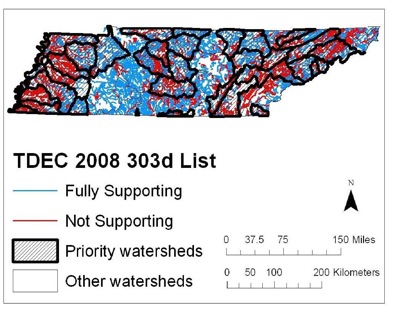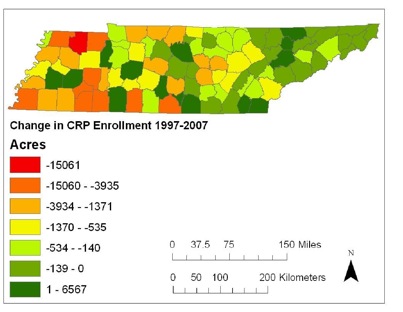 |
April 2010
|
April 2010 // Volume 48 // Number 2 // Ideas at Work // v48-2iw4
Watershed-Scale Dynamics of Tennessee Farmland Enrollment in the Conservation Reserve Program: Implications for Environmental Extension
Abstract
Increased national focus on environmental quality requires Extension professionals to evaluate conservation policies and adapt outreach strategies accordingly. This case study applies spatial analysis techniques to evaluate watershed-scale changes in Tennessee farmland enrolled in the Conservation Reserve Program 1997-2007, focusing on areas that may contribute to stream quality impairment. Results indicate that cumulative enrollment in the program has decreased significantly less in watersheds targeted by interagency outreach efforts than in the remainder of the state. Integration of geospatial technologies into cooperative educational programs that complement watershed restoration strategies may represent an emerging opportunity for natural resources Extension.
Introduction
Private landowners control over 60% of the total land area of the United States (USDA ERS, 2002). This land contributes a vast majority of the ecosystem services that Americans enjoy, including the maintenance of soil, water, and air quality; carbon sequestration; and the provision of wildlife habitat (Grumbine, 1994). Increased public awareness of environmental issues, as well as greater recognition of ecological problems, has led to the search for effective policy mechanisms for restoration of private lands. Contemporary Extension professionals serve as a vital link between landscape-scale restoration policies and private landowners who own the farms, forests, and other lands targeted by conservation planners.
The United States Department of Agriculture (USDA) Conservation Reserve Program (CRP) was originally authorized by the 1985 Food Security Act with the primary goal of reducing soil erosion and resulting sedimentation of surface waters. The program was designed to retire highly erodible lands from production by converting these fields to forests or grasslands. Landowners participating in the program typically receive an annual rental payment, plus up to half the cost of establishing permanent vegetation. Numerous researchers have documented CRP benefits to water resources ( e.g., Young & Osborn, 1990), and ecosystem health (e.g., Dunn, Stearns, Guntenpergen, & Sharpe, 1993).
Clearly, the success of soil and water conservation policies is dependent upon the involvement of Extension professionals in understanding the spatial aspects of environmental policies and subsequently communicating to landowners the ecological goals and potential benefits of program participation (Benham, Braccia, Mostaghimi, Lowery, & McClellan, 2007). The application of basic geographic information systems (GIS) allows for conservation planners to more rapidly explore watershed features and to more effectively articulate ecological data and land use patterns to stakeholders (Berry, Delgado, Khosla, & Pierce 2003). This article summarizes the use of these technologies to explore changes in farmland enrollment in the CRP and presents several lessons for watershed-based environmental Extension.
Study Area and Methods
The landscape of Tennessee varies greatly, stretching from the Mississippi Alluvial and Coastal Plain in West Tennessee to the Smoky Mountains in East Tennessee. Agricultural crop production is focused in the western counties, while livestock operations are common throughout the state. Despite these vast differences in physical geography, similar policy instruments are used to guide natural resource management throughout the state.
The Tennessee Department of Environment and Conservation, Division of Water Pollution Control is the primary state water resources agency, responsible for water quality permitting and also for monitoring over 60,000 miles of streams and rivers. The Tennessee Department of Agriculture provides technical and financial assistance to communities regarding the reduction of nonpoint-source pollution. The USDA CRP is the state's largest private land conservation initiative. Financial and technical resources necessary for this program are provided through the USDA Farm Service Agency and USDA Natural Resources Conservation Service, respectively. Additionally, the University of Tennessee Agricultural Extension Service and local county Soil and Water Conservation Districts cooperate in the administration of these programs.
The Clean Water Action Plan was jointly released in 1998 by the Environmental Protection Agency and the USDA to guide watershed restoration on a national scale. As a part of this plan, Tennessee 8-digit hydrologic unit code (HUC) watersheds were categorized based upon current water quality assessment data, resulting in the development of Tennessee's Unified Watershed Assessment (TDEC, 1998). This plan established priority watersheds as those in which over 15% of assessed stream miles are impaired according to the 303d list, illustrated in Figure 1.
Figure 1.
Tennessee HUC-8 Priority
Watersheds and Streams

Cumulative acreage enrolled in the CRP was obtained from the USDA Farm Service Agency. Digital shapefiles of Tennessee HUC-8 watersheds and counties were analyzed using ESRI ArcGIS 9.2. Counties were joined to watersheds based upon whether or not the majority of the county drained to a priority watershed. Data used during this project was obtained from publicly accessible sources, exchanged via file transfer protocol (ftp) server, and examined in the University of Tennessee Martin agricultural technology lab.
Results and Implications
Consistent with national trends, Tennessee farmland enrollment in the CRP has decreased overall. However, for the purposes of the study reported here, enrolled acreage is summarized as the sum of counties based upon location within a priority watershed. Results are summarized in Table 1.
| Acres Enrolled in 1997 | Acres Enrolled in 2007 | Reduction (%) | |
| Priority watersheds | 292,356 | 227,881 | 22 |
| Non-priority watersheds | 79,583 | 46,150 | 42 |
Geospatial visualization of results allows for the identification of counties where major changes in program enrollment have occurred. The geographic distribution of changes in CRP enrollment is illustrated in Figure 2. Most significantly, urbanizing areas in central counties of West Tennessee, Middle Tennessee (Nashville), and East Tennessee (Knoxville), show increases in the number of acres enrolled. This trend may support the finding of Parks & Schorr (1999), who illustrated the potential of the program to conserve open space in urbanizing areas.
Figure 2.
Changes in Conservation Reserve
Program enrollment in Tennessee

Because program enrollment in priority watersheds decreased far less than in non-targeted watersheds, this case study may illustrate partial effectiveness of interagency cooperation. As detailed by Baker (1989), local Extension and environmental education staff members play a major role in advertising, marketing, and educating the public on the benefits of natural resources stewardship. Therefore, integration of the CRP into a state's overall watershed management strategy may prove a cost-effective means of controlling non-point source pollution.
As described by Osborn (1993), agricultural commodity market fluctuations extend great influence on farmer choice regarding land enrollment in the CRP. In Tennessee, grain price fluctuations in recent years are likely strong influences on landowner decisions to enroll in conservation programs. Alternatively, researchers have identified links between Missouri landowner awareness of environmental programs and willingness to institute conservation practices (Valdivia & Poulos, 2008). Assuming that Tennessee landowner motivations are similarly derived, increased focus on Extension programs in impaired watersheds may provide one of the most efficient means to restore long-term watershed integrity. Future research will attempt to identify specific sociological and economic influences on Tennessee landowner decisions to participate in the CRP.
The project described here demonstrates a relatively simple example of how geographic information systems can be used to evaluate policy implementation on private land. While some may consider geospatial analysis to be one of the more sophisticated aspects of natural resource research, this project was conducted entirely using a desktop computer and software that should be readily available in county Extension offices. Additionally, this project illustrates that contemporary conservation initiatives may cross administrative and county boundaries.
Although watershed-scale educational program delivery may not fit the traditional Cooperative Extension paradigm, evolving ecological needs require that strong partnerships be developed among different county Extension offices, regulatory agencies, and other natural resource entities. Collaboration among professionals in environmental, agricultural, and economic development program areas may help to provide the interdisciplinary expertise necessary for successful watershed-based educational programs. Rather than relying on the primary campus for cartographic expertise, Extension personnel with basic training in GIS should be able to contribute substantially toward environmental outreach efforts. In summary, this case study illustrates vast potential for geospatial technologies to aid Extension educators by helping communicate to stakeholders the spatial dimensions of landscape change, environmental policy initiatives, and watershed-scale conservation goals.
References
Benham, B. L., Braccia, A., Mostaghimi, S., Lowery, J. B., & McClellan, P. W. (2007). Comparison of best management practice adoption between Virginia's Chesapeake Bay Basin and Southern River Watersheds. Journal of Extension [On-line], 45(2) Article 2RIB3. Available at: http://www.joe.org/joe/2007april/rb3.php
Berry, J. K., Delgado, J. A., Khosla, R., & Pierce, F. (2003). Precision conservation for environmental sustainability. Journal of Soil and Water Conservation, 58: 332-339.
Dunn, C. P., Stearns, F., Guntenpergen, G. R., & Sharpe D. M. (1993). Ecological benefits of the Conservation Reserve Program. Conservation Biology, 7: 132-139.
Grumbine, R. E. (1994). What is ecosystem management? Conservation Biology, 8: 27-38.
Osborn, T. (1993). The Conservation Reserve Program: Status, future, and policy options. Journal of Soil and Water Conservation, 48: 271-278.
Parks, J. P., & Schorr, J. P. (1997). Sustaining open space benefits in the Northeast: An evaluation of the Conservation Reserve Program. Journal of Environmental Economics and Management, 32: 85-94.
Tennessee Department of Environment and Conservation. (1998). Tennessee Unified Watershed Assessment.
United States Department of Agriculture, Economic Research Service. (2002). Major uses of land in the United States. EIB 14.
Valdivia, C., & Poulos, C. (2008). Factors affecting farm operators' interest in incorporating riparian buffers and forest farming practices in northeast and southeast Missouri. Agroforestry Systems, 75: 61-71.
Young, T., & Osborn, L. (1990). Costs and benefits of the Conservation Reserve Program. Journal of Soil and Water Conservation, 45: 370-373.




